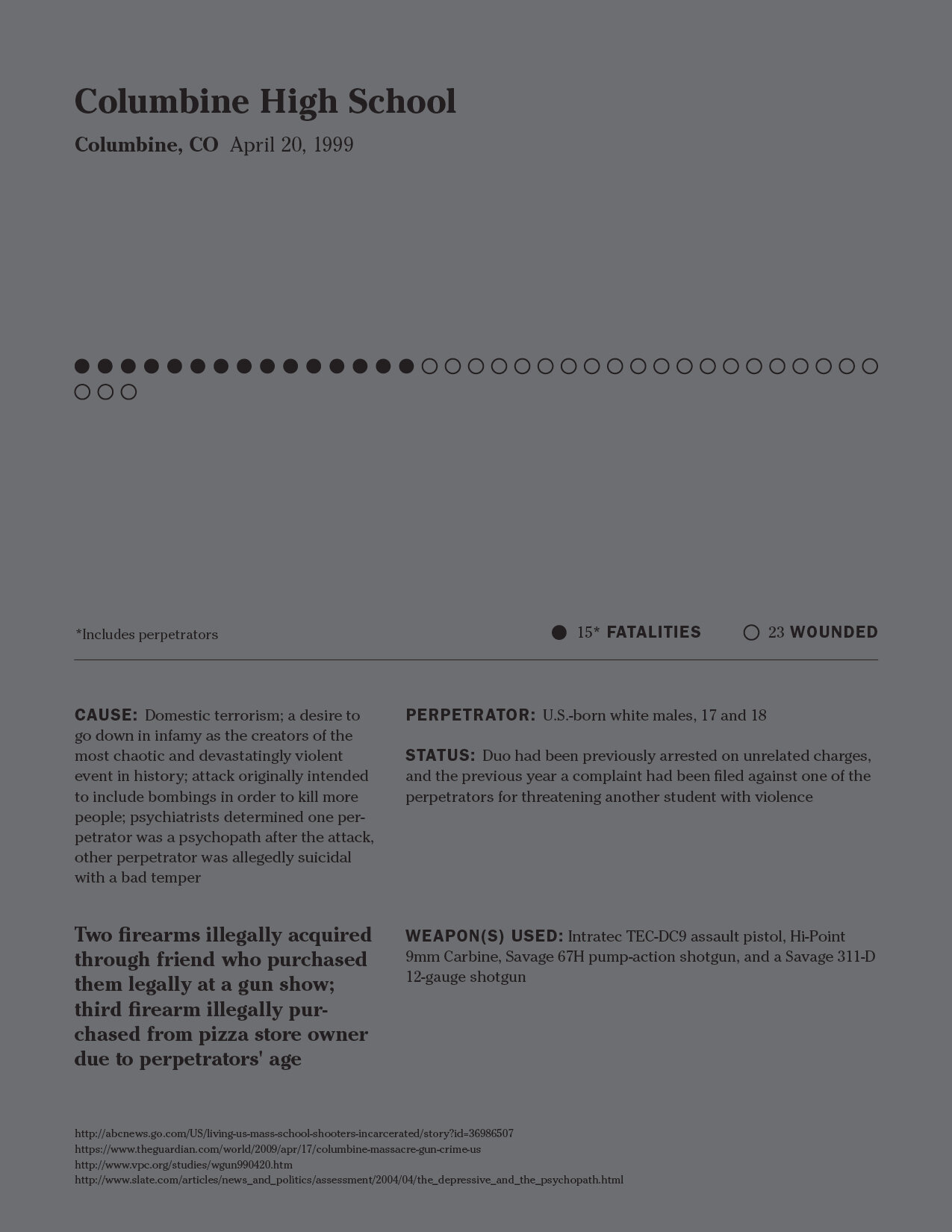Thoughts & Prayers
Design Activism / Master’s Thesis
An 8,000+ page, research-driven comparison of mass shootings and gun control legislation in the United States
The inalienable right to bear arms is as integral to America as stolen land and profit derived from another people’s labor. It was the second most important thing the founding fathers felt needed to be included in the Bill of Rights, just after the right to say whatever you want on the internet. This makes regulation tricky, as there was no way our early leaders could have predicted the advancements we would see in firearms technology over the past two and a half centuries. This is the root of our inability to legislate gun ownership — the right to keep, handle, and use a firearm is written into the very fabric of our nation.
Unfortunately, this right has had a role in the pervasive problem of gun violence in this country. It has been my goal here to compile every attempt by the federal government to regulate the sale and use of firearms and to reduce gun violence. This illustrates that, no matter how many times an event of mass human casualty occurs at the hands of someone with a firearm, no real change has been made. This publication acts as an interactive data visualization, a timeline of tragedy and the thwarted efforts to prevent future tragedy. This book consists of the 26 years of gun control legislation and 26 years of mass shootings I have seen in my lifetime. These are compared through paper color: passed legislation is on white paper, failed legislation on blue, and pending legislation on cream. The mass shootings are then printed on black paper so one may see the punctuations of mass violence throughout years of obstructionist Congresses.
It needs to be acknowledged that gun violence is a much larger problem than simply mass shootings. It is obvious here that they do not. It is not my intent to boil down this massive humanitarian crisis into the single hot-button issue which receives the most news coverage. Only 1.49% of all gun deaths are the result of a mass shooting.2 Suicide constitutes the vast majority of firearm deaths, making up 62% of all gun deaths in 2010, followed by homicides, accidental deaths, and police shootings.1 Gun violence is a multi-faceted problem affected by factors such as mental health, toxic masculinity, institutional racism, poverty, and many more; and, though mass shootings are not the largest problem we face in this gun debate, they are the most destructive in the shortest amount of time. They are the events that, in theory, should spur legislative action.
Overall, I found that the vast majority of congresspeople sponsoring commonsense gun control legislation were Democrats by a factor of nearly six. Democrats were also more likely to sponsor legislative solutions aimed at stopping the violence before it happened, while Republican-sponsored legislations focused heavily on punitive measures such as minimum sentences and mandatory death penalties. I found gun control provisions on their own and tucked within larger bills, such as early iterations of No Child Left Behind (these provisions were left out in the final bill which became law). Many bills were proposed every two years with few changes, some up to six or seven times.
The legislation I felt most appropriate to include is geared towards preventing intentional death by civilians. This includes efforts to curb domestic violence homicides, shooting events with mass casualties, and gang-related murders. There is a great deal of legislation that I left out for the sake of brevity and its tangential nature to the specific issue covered in this book, though it is no less important.
This book does bring light to one aspect of the pervasive problem of gun violence in America, as well as into prior and current legislative efforts to curb it.
This book does not address every issue relating to gun violence, nor suggest a concrete solution.
Laser printing, modified kettle stitch
8,000 pages
2018



